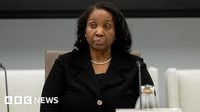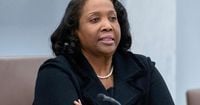The U.S. Supreme Court has stepped squarely into the center of a high-stakes battle over the independence of the Federal Reserve, issuing a pivotal ruling on October 1, 2025, that temporarily blocks the Trump administration’s attempt to immediately remove Governor Lisa Cook from the central bank’s influential Board of Governors. The decision, delivered in an unsigned order, not only preserves Cook’s seat for the time being but also signals that the nation’s highest court is prepared to scrutinize the extent of presidential power over independent regulatory agencies—a question that could reshape the balance of power in Washington and reverberate through global markets.
The roots of this legal and political standoff trace back to August 2025, when President Donald Trump, frustrated by the Federal Reserve’s refusal to cut interest rates as deeply as he wanted, announced he was firing Cook. The administration cited allegations of mortgage fraud predating her appointment, claims Cook has consistently denied. According to BBC, Cook immediately sued, arguing that her removal was illegal and would open the door to dangerous political interference in the Fed’s operations. No president has ever attempted to remove a sitting Fed governor before, and the law states that such officials can only be dismissed “for cause”—though, notably, that term is undefined and there’s no established procedure for such a firing.
Lower courts sided with Cook, ruling that a Federal Reserve governor can only be dismissed for misconduct during their term, not for alleged actions before their appointment. A federal judge put a stay on her firing, a decision now upheld by the Supreme Court’s order. As a result, Cook will remain on the board at least until oral arguments are heard in January 2026, ensuring her participation in critical monetary policy meetings scheduled for the remainder of 2025. This continuity has been welcomed by many in the financial sector, who see it as a stabilizing force amid mounting political pressures.
Cook’s tenure is significant not just for her own career but for the institution as a whole. Appointed in May 2022 and reappointed in September 2023, her term is set to run until January 31, 2038—a long horizon that underscores the lasting impact any decision about her removal could have. As a member of the board that sets the Federal Reserve’s benchmark interest rate, Cook’s votes directly influence the direction of U.S. monetary policy, affecting everything from mortgage rates to the cost of business loans. According to her attorneys, the Supreme Court’s decision “rightly allows Governor Cook to continue in her role on the Federal Reserve Board, and we look forward to further proceedings consistent with the Court’s order.”
The Trump administration, for its part, remains resolute. White House Press Secretary Karoline Leavitt told reporters, “The administration looks forward to that case being fully played out at the Supreme Court.” Trump himself has repeatedly criticized the Fed for not cutting rates more aggressively, arguing that lower rates would help bring down inflation and mortgage costs. He even floated the idea of firing Fed Chairman Jerome Powell—an unprecedented move—though he ultimately backed down after a strong market reaction and legal questions about the legitimacy of such a step.
The Supreme Court’s intervention is seen by many as a temporary safeguard for the central bank’s independence, a principle that has long underpinned the credibility of U.S. monetary policy. Esteemed former Fed chairs Alan Greenspan, Ben Bernanke, and Janet Yellen submitted an amicus brief urging the Court to prevent Cook’s immediate removal, warning that such a move could erode public confidence in the Fed and destabilize financial markets. Their message was clear: the independence of the central bank is not just a bureaucratic nicety—it is a cornerstone of economic stability.
For now, financial markets have breathed a sigh of relief. The prospect of abrupt, politically motivated changes to the Fed’s leadership had raised concerns about unpredictable shifts in interest rate policy, which could have rattled banks like JPMorgan Chase and Bank of America, as well as tech giants such as Apple and Microsoft, which are sensitive to changes in discount rates. According to Market Minute, the decision to delay Cook’s removal “implies a more predictable monetary policy outlook,” at least in the short term, allowing companies and investors to plan with greater confidence.
Yet, beneath this veneer of stability, uncertainty still simmers. The Supreme Court’s order is not a final verdict; it simply sets the stage for oral arguments in January 2026, when the justices will grapple with the thorny question of whether a president can unilaterally remove a Fed governor. The outcome could set a precedent not just for the Federal Reserve, but for all independent agencies—including the Securities and Exchange Commission and the Federal Communications Commission—potentially redefining the scope of executive power across the federal government.
The broader significance of this case extends far beyond the personalities involved. It touches on a fundamental debate about the appropriate balance between political accountability and the autonomy required for central bankers to make tough, sometimes unpopular decisions in the nation’s long-term interest. Internationally, the case is being watched closely by foreign governments and global investors, who rely on the institutional strength of the U.S. financial system as an anchor for the world economy. Any perception that the Fed is vulnerable to political meddling could undermine confidence in the U.S. dollar and trigger volatility in currency and bond markets.
Interestingly, the Trump administration has not limited its efforts to reshape the Fed to the Cook case alone. In a highly unusual move, Trump appointed his head economic adviser, Stephen Miran, to temporarily fill a vacancy on the board—a step seen by some as an attempt to exert greater influence over the central bank’s direction. Meanwhile, the Fed itself has moved cautiously, announcing its first rate cut in nearly a year on September 17, 2025, with Chairman Powell emphasizing that the decision was driven by economic data, not political pressure. The board is scheduled to meet again at the end of October and in December, with Cook now assured a vote at both sessions.
Looking ahead, the outcome of the Supreme Court’s January hearing could reshape the contours of American economic governance for years to come. If the justices affirm the “for cause” removal standard, it would reinforce the Fed’s autonomy and help insulate monetary policy from shifting political winds. If, on the other hand, they grant the president broader authority to remove governors, it could open the door to greater political influence over the central bank, with unpredictable consequences for markets, businesses, and households alike.
For now, Governor Lisa Cook remains at her post, the Federal Reserve’s independence is preserved—at least temporarily—and the eyes of the financial world are fixed on the Supreme Court, waiting for the next chapter in this extraordinary legal and economic drama. The stakes, for the Fed and for the U.S. economy, could hardly be higher.






